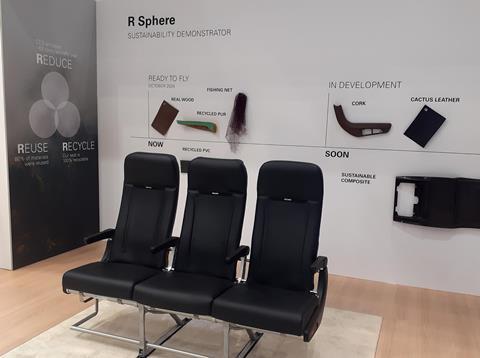Recaro Aircraft Seating is expecting to certify the first four materials integrated into its ‘R Sphere’ sustainability demonstrator this October, the manufacturer confirmed during an AIX briefing in Hamburg, with potential buyers now being offered the options upon request.
The company says a further three materials are also currently being explored.

Subject to upcoming EASA certification, the first four more sustainable materials – including recycled foam, recycled plastic, real wood and upcycled fishing net – will be integrated into seats without adversely affecting overall weight and, crucially, impacting stringent safety regulations.
Citing increased environmental concern among both passengers and the manufacturer itself, “we believe some airlines do as well” says a spokesperson for Recaro, noting that if “just one or two airlines think it’s good” the novel product range could initiate positive change.
Innovations to be initially introduced onto the newly-renamed R1 and R2 short-haul economy seats, part of a wider product rebranding unveiled at the show, include recycled foam (procured from old mattresses) in the seat base and back panel: “probably the most expensive process,” admits Recaro, with the overall seat to be listed for an estimated 10% on top of comparable list price.
Contemplating whether airlines would be happy to pay a ‘sustainability premium,’ “we don’t know if we’ll get something out it” mused the manufacturer, who nevertheless remain hopeful that “something has to be shown” and that “the trend sphere will take some time”.
Another novel material pending certification is the use of repurposed fishing net for seatback pockets, perhaps the most complex to certify.
Although its structural integrity “doesn’t really change, even being in the sea for a long time,” Recaro has identified two methods with which it might be permissible to use: either by identifying each separate net’s manufacturer via identification labels, or testing each recovered net (roughly sufficient for one ship-set of seats) individually – a process largely concerned with flammability. Arguably less critical is the potential for colour variation, but something which airlines may still show concern with.
“It’s important it still needs to look like a high-tech product – something [airlines] trust,” the company says, noting the qualities of another material currently under consideration: ‘’leather’ made from cactuses, a product just as durable as its animal-derived counterpart. Sugar cane composite is also being explored for rear seat covers, as is the use of injection-moulded armrests containing 30% cork (a naturally inflammable material).
With the initial four materials set to receive certification in October, Recaro concludes that until regulatory approvals for other initiatives also under development – such as 3D printed seat legs – mature, saving weight across its entire range (with its R1 seat weighing in at just 8.5kg) will continue to drive fuel efficiency and therefore help airlines’ sustainability goals.
Recaro has at the show on 27 May announced a rebranding of its seating products, ranging from R1 to R7, reflecting the various classes and complexities of the seating solutions. For example its SL3710 short/medium-range economy seat has been rebranded R1, while its CL6720 lie-flat business class seat is now rebranded to R7.


























